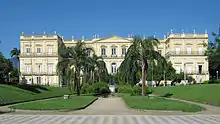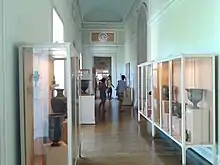
Exhibition of Greco-Roman antiquities in the museum.
The National Museum of Rio de Janeiro collections include an exhibition of Mediterranean antiquities from Etruscan, Greek (Italiote) and Roman civilizations.[1]
The current status of the collection is unknown after the fire that destroyed the museum in 2018.
| Image | Name | Origin | Date | Notes |
|---|---|---|---|---|
 |
Proto-Corinthian Ring Askos | Greek (Italiote) civilization | 7th century B.C. | [2] |
 |
Mirrors | Greek (Italiote) civilization | 6th century B.C. | [3] |
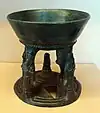 |
Caryatid chalice | Etruscan civilization | c. 620-560 B.C. | [4] |
 |
Fresco from Pompeii: Basket and birds | Roman civilization | 1st century A.D. | [5] |
_01.).jpg.webp) |
Red-figure chalice krater | Greek (Italiote) civilization | 4th century B.C. | [6] |
 |
Red-figure bell krater | Greek (Italiote) civilization | 4th century B.C. | [7] |
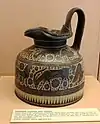 |
Corinthian oinochoe with lid | Greek (Italiote) civilization | c. 600-575 B.C. | [8] |
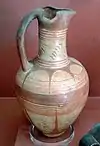 |
Proto-Corinthian oinochoe | Greek (Italiote) civilization | 7th century B.C. | [9] |
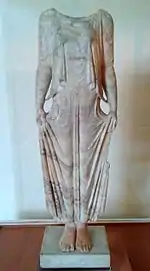 |
Statue of a headless woman | Greek or Roman civilization | 5th century B.C. | [10] |
 |
Frasco geminado com duas alças | Roman civilization | [11] | |
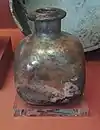 |
Square-shaped flask with handle | Roman civilization | 1st century A.D. | [12] |
 |
Etruscan warrior | Etruscan civilization | 5th century B.C. | [13] |
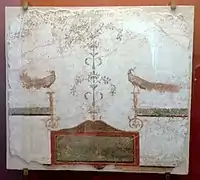 |
Fresco from Pompeii: Peacocks | Roman civilization | 1st century A.D. | [14] |
_01.jpg.webp) |
Female nude torso | Greek or Roman civilization | [15] | |
 |
Fresco from Pompeii: Seahorse | Roman civilization | 1st century A.D. | [16] |
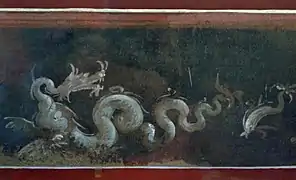 |
Fresco from Pompeii: Sea dragon | Roman civilization | 1st century A.D. | [16] |
See also
Wikimedia Commons has media related to Mediterranean antiquities in the Museu Nacional.
References
- ↑ "Culturas do Mediterrâneo" (in Portuguese). National Museum of Brazil. Retrieved 4 September 2018.
- ↑ "Askós ítalo-protocoríntio em forma de anel" (in Portuguese). National Museum of Brazil. Retrieved 4 September 2018.
- ↑ "Cabos de espelhos" (in Portuguese). National Museum of Brazil. Retrieved 4 September 2018.
- ↑ "Cálice com cariátides" (in Portuguese). National Museum of Brazil. Retrieved 4 September 2018.
- ↑ "Cesto suspenso entre guirlandas" (in Portuguese). National Museum of Brazil. Retrieved 4 September 2018.
- ↑ "Cratera em cálice, italiota" (in Portuguese). National Museum of Brazil. Retrieved 4 September 2018.
- ↑ "Cratera em sino, italiota" (in Portuguese). National Museum of Brazil. Retrieved 4 September 2018.
- ↑ "Enócoa coríntia com tampa" (in Portuguese). National Museum of Brazil. Retrieved 4 September 2018.
- ↑ "Enócoa coríntia com tampa" (in Portuguese). National Museum of Brazil. Retrieved 4 September 2018.
- ↑ "Escultura feminina sem cabeça" (in Portuguese). National Museum of Brazil. Retrieved 4 September 2018.
- ↑ "Frasco geminado com duas alças" (in Portuguese). National Museum of Brazil. Retrieved 4 September 2018.
- ↑ "Frascos de forma quadrangular" (in Portuguese). National Museum of Brazil. Retrieved 4 September 2018.
- ↑ "Guerreiro etrusco" (in Portuguese). National Museum of Brazil. Retrieved 4 September 2018.
- ↑ "Pavões sobre candelabros" (in Portuguese). National Museum of Brazil. Retrieved 4 September 2018.
- ↑ "Torso nu" (in Portuguese). National Museum of Brazil. Retrieved 4 September 2018.
- 1 2 "Afrescos de pompeia" (in Portuguese). National Museum of Brazil. Retrieved 4 September 2018.
This article is issued from Wikipedia. The text is licensed under Creative Commons - Attribution - Sharealike. Additional terms may apply for the media files.
